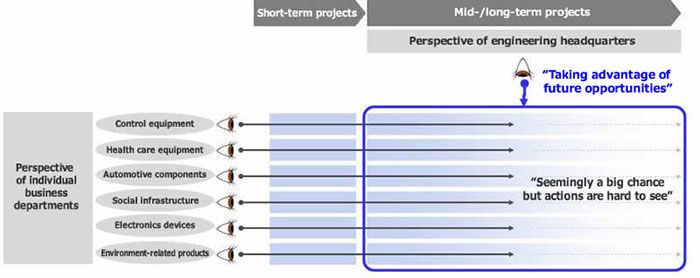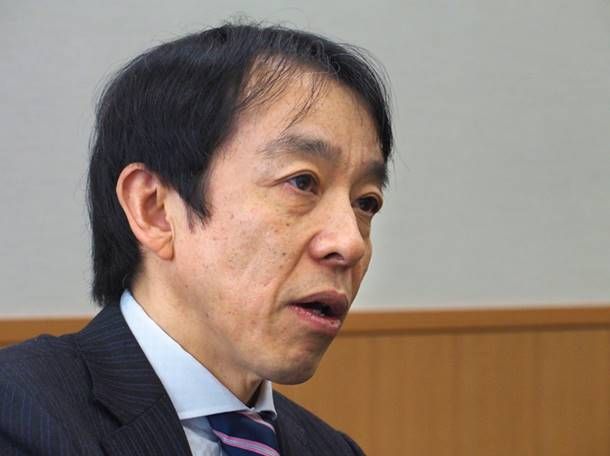News -
Omron's CTO Talking About "Technology-Oriented Management"
Kiichiro Miyata, Managing Director and CTO, Omron Corporation Interviewed by the Longine IR Department
The Longine IR Department interviewed Kiichiro Miyata, Managing Director and CTO at Omron Corporation (securities cord: 6645; hereafter "Omron") about the roles of CTO, Omron's technological strengths as well as future achievements the company promotes.
Three key points presented by the Longine IR Department to investors
- Omron's CTO overseeing technology strategies of the entire group from a management perspective.
- Omron's strengths found in "component technologies".
- Creating new values through multi-business operation × automation.
The role of CTO: Applying a bird's-eye managerial view to technologies
Longine IR Department (hereafter Longine):
Omron has established the new position of CTO (Chief Technology Officer) in 2015. Could you detail the position and the roles of CTO?
Kiichiro Miyata, Managing Director and CTO, Omron Corporation (hereafter Miyata):
At Omron, there was previously a position ranked as the head of engineering headquarters, where core technologies are developed. The difference between this newly established CTO and of the conventional position lies in the clearly re-defined responsibility to build technology strategies as part of managerial practices.
Longine:
Each business department at Omron may have already built strategies based on technologies. What difference exactly will the existence of CTO make?
Miyata:
Here is something I found out after becoming CTO: Advancing the company system to the limit can mature technologies of each department. However, there is the possibility of overlooking needs spanning two different business fields. It may also narrow our views when thinking of far-off future strategies. Therefore, we need someone who can read future technological trends across business borders to enable the group's reasonable decision making.
Longine:
Having a long-term perspective is surely necessary when thinking about future technological trends, isn't it? Have you ever experienced any trouble because you lacked a long-term point of view so far?
Miyata:
I was in charge of the health care business before taking office as CTO. When I was in charge of network services for the health care equipment as the development supervisor, I established all systems based on PCs. However, with the rapid spread of smartphones entailed a lot of troubles and costs. It is a bitter memory that I couldn't foresee the rapid spread of smartphones.
Longine:
I must agree that the spread of smartphones was surprisingly quick. As the CTO, how far ahead do you plan to predict technological tides and social changes?
Miyata:
The target is currently set for around 2030. But precise prediction is often difficult because mega changes can come in a blink, just like in the case of smartphones. For example, however, as far as the acceleration of factory automation is concerned, this automation trend will not stop, considering the needs for labor saving and enhanced safety. My prediction involves preparing several scenarios on what kind of change will happen in what kind of form. Based on this prediction, we are positively going to work on technologies and applications considered keys to address the needs.

Source: Provided by the company
Longine:
How do you combine your core technologies and future scenarios in management?
Miyata:
I will roughly explain, since I cannot disclose this in detail. At first, we create a matrix, in which our technologies including ones called flagship projects, social changes and our multiple core technologies are placed along different axes. Then, we map our efforts at intersections, based on which we assess how each activity is currently related with the flagship projects or how we can dig deep from now.
Longine:
As a result of having mapped your efforts, what will be your decision for areas where Omron is not performing very well or even missing in your business operation?
Miyata:
We will utilize external resources through M&A, investment, and open innovation. But 'open' doesn't mean to blindly and randomly use external resources. We discuss beforehand to decide what domains will need outside resources, after mapping. When we purchased Adept Technology, a U.S.-based robot manufacturer in October 2015, it was also supported by a future scenario suggesting that we should purchase the domain since we needed it for future use.

Kiichiro Miyata, Managing Director and CTO, Omron Corporation
Photo: Longine photograph department
Omron's technological strengths: Combination and incorporation of various technologies
Longine:
Please describe technological strengths of Omron.
Miyata:
Simply put, they are "technologies to combine our various element technologies in the form of components according to customer needs". Core technologies I mentioned when explaining about matrix mapping are part of Omron's technologies. However, when looking at each of them, you'll see all of them are not sharply honed. Some of them are among the best venture businesses in the world as far as technological excellence is concerned. But when it comes to combining various technologies to incorporate into a single product form according to customer needs rather than pursuing specific technical domains, we have a competitive advantage over others.
Longine:
Could you explain more in detail about the "strength of incorporating technologies into a component"?
Miyata:
Even if companies have superior core technologies, it's difficult to incorporate them into components or final products. There are also hardware and cost constraints to solve. For example, venture companies can have outstanding element technologies, but they seldom own technologies to incorporate them into products. In-depth hardware knowledge is paramount to do so. Naturally, there is a difference between companies with and without the experience and expertise of accumulating both intensive and extensive hardware knowledge and exploiting it to build hardware performing at over 100 percent.
Omron's technological evolution
Longine:
"Sensing & Control" has become familiar with us as the phrase expressing Omron's technological concept. However, we see the word "+ Think" has been added recently. What is your idea behind this?
Miyata:
"Sensing & Control" means to sense the state of things (Sensing) and process and control the information (Control). "Sensing & Control + Think" represents the addition of human thought (Think) in the process. For example, a control system that can achieve know-how allowing expert workers to work in accordance with the situation while providing programmed routine operations is a situation where "Think" aspect, or so-called human wisdom is involved. If it's a blood pressure monitor, it not only measures blood pressure, but also shows additional information the user may want, namely, other health-related indexes, when sensing an abnormal value. This is how "Think" is reflected in products.
Creating Omron's values toward future
Longine:
In what scenes do you image Omron's technologies will be used in the future?
Miyata:
Omron is based on the original philosophy: To the machine the work of machines, to man the thrill of further creation, inherited since the founding of the company. We strive to realize a future where people and machines collaborate in various scenes including factory automation (FA) and other industrial zones, as well as social, life and environmental applications.
Longine:
Regarding "automation with the machine", where does Omron's strength lie?
Miyata:
It lies right in the "+ Think" domain. For example, machines used in factory automation of production sites will approximate human movements much more faithfully in the future. When any special trouble occurs, these machines may think about the situation by themselves and control, or accurately stop production lines without the need of human operation and decision making.
Longine:
As for "automation", will there be applications crossing over multiple business domains?
Miyata:
Our business domains are highly diversified, including the automotive, health care and control technology segments and with abundant stocks of technologies and ideas. As a result, cross-over efforts extending beyond conventionally-defined domains are expected by many customers. For example, automatic driving being developed by the automotive division requires the function to check that the driver is in a normal state of consciousness to ensure safety more than ever, which forms a critical collateral of accountability. In this context, we can integrate biological information sensing technology owned by the health care business to develop an application to stop driving automatically when the driver is judged to be in an abnormal state. It is easy to install many sensors to monitor the state of human bodies for laboratory applications. However, the actual situations are far more demanding than that, requiring the use of a minimum number of sensors, easy-to-use operation as well as enhanced precision. Therefore, special incorporation technologies become indispensable.
Longine:
I see. In addition to "Sensing & Control + Think" technologies, the diversity of your business domains and incorporation technologies are used in such scenes. Thank you very much for your time today.
Miyata:
It was my pleasure. Thank you.
YOU MIGHT ALSO LIKE
Topics
- Engineering industry
Categories
- investorrelations
- management
- technologies